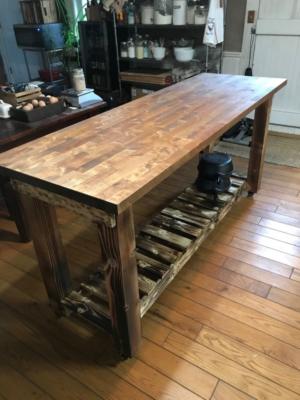 When you want to add some extra warmth and natural color to your kitchen, few ways work better than adding butcher block counters. These sturdy countertops have forgiving surfaces that, when properly coated with sealants or oils, resist liquids and most stains. While many people use mineral oil to treat their butcher blocks due to its food-safe formulation, mineral oil never really dries and doesn’t have a waterproof finish. This means liquids can soak through to the wood and stain it, potentially getting into your food or spreading around your home. Unfortunately, before you can seal it properly with more suitable sealants like tung oil or beeswax, you need to remove all the mineral oil from your wood surface.
When you want to add some extra warmth and natural color to your kitchen, few ways work better than adding butcher block counters. These sturdy countertops have forgiving surfaces that, when properly coated with sealants or oils, resist liquids and most stains. While many people use mineral oil to treat their butcher blocks due to its food-safe formulation, mineral oil never really dries and doesn’t have a waterproof finish. This means liquids can soak through to the wood and stain it, potentially getting into your food or spreading around your home. Unfortunately, before you can seal it properly with more suitable sealants like tung oil or beeswax, you need to remove all the mineral oil from your wood surface.
What Are the Benefits of Oil Removal from Wood?
When you want to give your counters or cutting boards a sealant makeover, it doesn’t make sense to add other products on top of a wet oil like mineral oil. If you intermix it with a new sealant, you prevent absorption and leave your surface vulnerable. Removing mineral oil from wood surfaces like butcher blocks makes them porous again to ensure sealants like tang oil properly permeate your counters or cutting boards. Additionally, removing the mineral oil finish gives you an opportunity to visually inspect the clean wood surface for damages and stains, making it easier to start out your project with a blank slate. When you start out with an even, uniform surface, you’re more likely to achieve even, uniform results with your new sealant.
What Supplies Work for Removing Mineral Oil?
Several highly effective products help you easily remove mineral oil from your butcher block counters or cutting boards. Of these, citric solvent, grain alcohol and odorless mineral spirits offer safe, quick solutions to mineral oil removal, and both they and naphtha won’t overwhelm you with chemical smells like paint or lacquer thinner. A combination of Dawn dish soap and water also gets the job done, but it sometimes raises the grain of the wood and thus requires sanding. TSB cleaner takes mineral oil off wood as well, though it has the potential to oxidize the wood. This oxidation typically makes your butcher block surface darker, which might prove handy if you want deeper, richer color in your kitchen.
How Do You Remove Mineral Oil from Wood?
How you remove mineral oil from wood surfaces depends on the products you use for the task. When using citric solvent or odorless mineral spirits, you first flush the surface, then use a soft scrub brush to gently bring the mineral oil up from the surface. After that, mop up the product from the surface before it dries using paper towels. Keep in mind that mineral oil soaks deep into porous surfaces like wood, so you never really get all of it off your counter or cutting board. Sanding after you finish stripping it, however, can help you reach a nice starting point for adding new sealant. Once you get to that blank slate state, apply whichever butcher block sealant you’ve chosen and give it a chance to cure.
Butcher block counters might seem like they require lots of maintenance, but once you treat them with sealants that keep out water and stains, that changes considerably. By removing mineral oil finishes from your counter, you open your kitchen decor up to a world of decorative possibilities, including finishing your butcher block with various shades of tang oil that showcase its grain while protecting its integrity and elevating the look of your existing room design.



